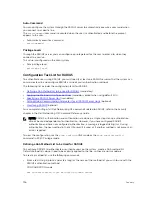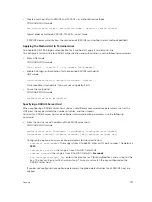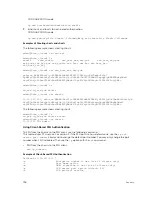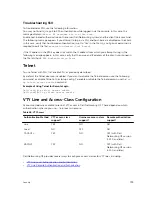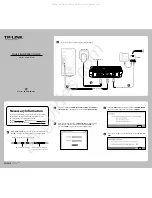
VTY Line Local Authentication and Authorization
Dell Networking OS retrieves the access class from the local database.
To use this feature:
1.
Create a username.
2.
Enter a password.
3.
Assign an access class.
4.
Enter a privilege level.
You can assign line authentication on a per-VTY basis; it is a simple password authentication, using an
access-class as authorization.
Configure local authentication globally and configure access classes on a per-user basis.
Dell Networking OS can assign different access classes to different users by username. Until users
attempt to log in, Dell Networking OS does not know if they will be assigned a VTY line. This means that
incoming users always see a login prompt even if you have excluded them from the VTY line with a deny-
all access class. After users identify themselves, Dell Networking OS retrieves the access class from the
local database and applies it. (Dell Networking OS then can close the connection if a user is denied
access.)
NOTE: If a VTY user logs in with RADIUS authentication, the privilege level is applied from the
RADIUS server only if you configure RADIUS authentication.
The following example shows how to allow or deny a Telnet connection to a user. Users see a login
prompt even if they cannot log in. No access class is configured for the VTY line. It defaults from the local
database.
Example of Configuring VTY Authorization Based on Access Class Retrieved from a Local Database (Per
User)
Dell(conf)#user gooduser password abc privilege 10 access-class permitall
Dell(conf)#user baduser password abc privilege 10 access-class denyall
Dell(conf)#
Dell(conf)#aaa authentication login localmethod local
Dell(conf)#
Dell(conf)#line vty 0 9
Dell(config-line-vty)#login authentication localmethod
Dell(config-line-vty)#end
VTY Line Remote Authentication and Authorization
Dell Networking OS retrieves the access class from the VTY line.
The Dell Networking OS takes the access class from the VTY line and applies it to ALL users. Dell
Networking OS does not need to know the identity of the incoming user and can immediately apply the
access class. If the authentication method is RADIUS, , or line, and you have configured an
access class for the VTY line, Dell Networking OS immediately applies it. If the access-class is set to deny
all or deny for the incoming subnet, Dell Networking OS closes the connection without displaying the
login prompt. The following example shows how to deny incoming connections from subnet 10.0.0.0
without displaying a login prompt. The example uses as the authentication mechanism.
740
Security
Summary of Contents for Z9000
Page 1: ...Dell Configuration Guide for the Z9000 System 9 7 0 0 ...
Page 80: ...grub reboot 80 Management ...
Page 128: ... 0 Te 1 1 Te 1 2 rx Flow N A N A 128 Access Control Lists ACLs ...
Page 491: ...Figure 70 Configuring OSPF and BGP for MSDP Multicast Source Discovery Protocol MSDP 491 ...
Page 496: ...Figure 73 MSDP Default Peer Scenario 1 496 Multicast Source Discovery Protocol MSDP ...
Page 497: ...Figure 74 MSDP Default Peer Scenario 2 Multicast Source Discovery Protocol MSDP 497 ...
Page 498: ...Figure 75 MSDP Default Peer Scenario 3 498 Multicast Source Discovery Protocol MSDP ...
Page 760: ...Figure 100 Single and Double Tag TPID Match 760 Service Provider Bridging ...
Page 761: ...Figure 101 Single and Double Tag First byte TPID Match Service Provider Bridging 761 ...

